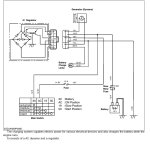unplug the regulator.
1: Test the 2 wires from the generator. Should be about 20v or more at idle (AC voltage). If ok, move on to #2. If not ok, check the wiring harness integrity. and/or the generator output (output from the generator at the two wires should be pretty high--minimum of 20v AC at idle, and should rise to 50-60v at full throttle)
#2 test the ground at the regulator connector. Black wire. Test between connector and batt negative terminal. Ok? Move on to #3. Not ok, check wiring. Good to use voltage drop test here, and backprobe the regulator while connected and engine running. Same test works great for the charge wire (red).
#3. Test the charge wire. Red in the regulator connector, and again, I highly suggest using a voltage drop test to do this. Put one probe of your volt meter (DVOM) in the connector red wire terminal; other probe on battery positive terminal. DVOM on volts DC. What's it read? Below 500mv (or 0.5v) is acceptable. Above that, check the integrity of the wire harness.
#4 check for 12v at the yellow wire, in the regulator connector with the key on. Do you have 12v? If yes, and all other tests are ok, you either missed something or you have a bad regulator. If you don't have 12v with teh key on, at the yellow wire, check the fuse, AND check the integrity of the harness.
Harness issues are not uncommon on these, just has to do with how the harness is routed, the nature of "lawn mowers" (they are hard on everything, being used in dirt, then get warshed off and all the chemicals from warshing tend to corrode copper wire)--hence I suggest using a voltage drop test especially for testing the charge (red) wire. Why? Because ONE strand of wire will show up on a continuity test as "good" but that one strand won't carry enough current to actually charge.



